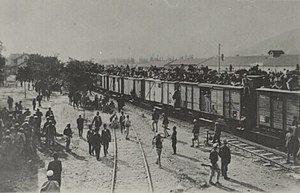Capture of Üskup
| Capture of Üskup | |||||||
|---|---|---|---|---|---|---|---|
| Part of Albanian revolt of 1912 | |||||||
 Albanian rebels entering Üsküp | |||||||
| |||||||
| Belligerents | |||||||
|
|
| ||||||
| Commanders and leaders | |||||||
|
Idriz Seferi Isa Boletini Bajram Curri |
Mehmed V Kara Said Pasha Ibrahim Pasha | ||||||
| Units involved | |||||||
| Ottoman Garrison | ||||||
| Strength | |||||||
|
500 (beginning)[5] More than 30,000 after the capture[6] | 4,000[5] | ||||||
The Capture of Üskup marked a significant event during the Albanian revolt of 1912. Led by Idriz Seferi,[7] Albanian rebels successfully seized Üskup from the Ottoman Authorities, which served as the capital of the Kosovo Vilayet at the time.[8][9][10] This capture prompted the Young Turk government in Constantinople to accept the Albanian demands, chief among them being the establishment of an Autonomous Albanian vilayet. The event also played a vital role in the creation of the Albanian state.[9]
Capture
[edit]In July 1912, Albanian rebels gathered their forces in Kosovo after successfully capturing major cities in the region, including Prishtina, Ferizaj, and Gjakova, which were previously under control of the Ottoman Empire.[11] As early August approached, Albanian troops embarked on a southern march towards the provincial capital, Üsküb (Skopje). On August 11, a group of approximately 200 Albanian rebels from Gjakova, led by Zef Kol Ndoka and Bajram Daklani entered Skopje.[12] Their actions included raising the Albanian flag within the city. However, they were ultimately forced to retreat after fighting with the Ottoman troops in the city.[12] On August 13, another contingent of Albanian soldiers from Karadak, led by Idriz Seferi and Isa Boletini, entered the city with a force of five hundred fighters.[5][13][14][15] They confronted the 4,000 Ottoman soldiers stationed there and demanded the immediate surrender of Üsküb to the Albanian rebels.[5] Following fighting on August 14, the Ottoman garrison surrendered, while more Albanian troops reached the city from the areas of Karadak,[13] Prishtina and Dibër.[3] On August 15, Bajram Curri marched into the liberated city, accompanied by over 30,000 rebels. As they entered Üsküp, the Albanians encountered no resistance from the city's inhabitants.[6][12] After capturing Üsküp, the Albanian rebels from Karadak, under Idriz Seferi marched towards Kumanova and Preševo, liberating both of them.[13][12][16] Meanwhile, a smaller unit marched towards Tetovo, also capturing it for the Albanian rebels.[12]
References
[edit]- ^ Nevila Nika: Po te mos dilte Idriz Seferi nga Shkupi, ai do te mbetej qytet shqiptar. Retrieved 2024-04-10 – via www.youtube.com.
- ^ Murati, Qemal (2012). STUDIME ALBANOLOGJIKE (PDF) (in Albanian). Skopje: Instituti i Trashëgimisë Shpirtërore e Kulturore të Shqiptarëve. pp. 139–151. ISSN 1857-6958.
- ^ a b c d Langer, William (2001). The Encyclopedia of world history: ancient, medieval, and modern, chronologically arranged. Houghton Mifflin Harcourt. p. 524. ISBN 0-395-65237-5.
- ^ Nevila Nika: Po te mos dilte Idriz Seferi nga Shkupi, ai do te mbetej qytet shqiptar. Retrieved 2024-04-10 – via www.youtube.com.
- ^ a b c d Luarasi, Skënder (2007). Angjelina Ceka (ed.). Tri jetë (in Albanian). Migjeni. pp. 274–5. ISBN 978-99943-943-1-9.
- ^ a b Vickers, Miranda (1999). The Albanians: a modern history. I.B.Tauris. p. 66. ISBN 1-86064-541-0.
- ^ Frashëri, Kristo (2008). Shpallja e pavarësisë së Shqipërisë: 28 Nëntor 1912 (in Albanian). Akademia e Shkencave e Shqipërisë. ISBN 978-99956-10-14-2.
- ^ Liotta, P. H.; Jebb, Cindy R. (2004). Mapping Macedonia: Idea and Identity. Greenwood Publishing Group. p. 62. ISBN 978-0-275-98247-8. Retrieved April 9, 2012.
- ^ a b Phillips, John (2004). "The rise of Albanian nationalism". Macedonia: warlords and rebels in the Balkans. London: I.B. Tauris. p. 29. ISBN 978-1-86064-841-0.
An Albanian uprising in Kosovo for independent schools in May 1912 led to capture of Skopje by rebels in August
- ^ Taru Bahl; M.H. Syed (2003). "The Balkan Wars and creation of Independent Albania". Encyclopaedia of the Muslim World. New Delhi: Anmol publications PVT. Ltd. p. 53. ISBN 978-81-261-1419-1.
The Albanians once more raise against Ottoman Empire in May 1912 and took Macedonian capitol of Skopje by August
- ^ Elsie, Robert (2004). Historical dictionary of Kosova. Internet Archive. Lanham, Md. : Scarecrow Press. ISBN 978-0-8108-5309-6.
- ^ a b c d e "Çlirimi i Shkupit – Enciklopedia Shqiptare" (in Albanian). Archived from the original on 2023-07-25. Retrieved 2023-07-25.
- ^ a b c Murati, Qemal (2012). STUDIME ALBANOLOGJIKE (PDF) (in Albanian). Skopje: Instituti i Trashëgimisë Shpirtërore e Kulturore të Shqiptarëve. pp. 139–151. ISSN 1857-6958.
- ^ Idriz Seferi kishte 10.000 ushtar, kunder Osmaneve, derisa Isa Boletini e te tjere kishin nga disa qindera! Shqiptaret e Karadakut e kane pasur barren kryesore te luftes antiosmane edhe ne vitet 1900-ta! E qe pastaj ata u islamizuan perdhuni nga hoxhallaret e ushtrise se Serbise!, retrieved 2023-07-25
- ^ "Pushtimi i Shkupit dhe ngritja e flamurit të Pavarësisë më 12 gusht 1912". www.forumishqiptar.com. Retrieved 2023-07-25.
Pra sulmin për marrjen e Shkupit e filluan nga Karadaku i Gjilanit, nëpër mes malit të Zi të Shkupit, nga fshati Luboten, anës së lindjes duke i rrënë Shkupit prapa shpinës. Ky manovrim i rrezikshëm por tejet efektiv, në taktikën uhtarake, e detyroi komandën supreme turke të heq dorë nga mbrojtja e mëtutjeshme e Shkupit e Kaçanikut, duke hapur rrugën shqiptarëve që pa luftë të marrëshonin drejt Shkupit.
- ^ "Idriz Seferi (1847-1927)". www.forumishqiptar.com. Retrieved 2023-07-25.
